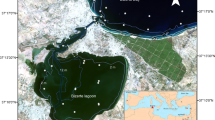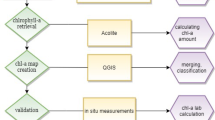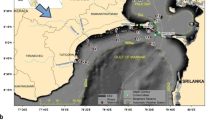Abstract
The spatiotemporal variability of the major phytoplankton groups, such as dinoflagellates and diatoms, provides crucial information about the ecosystem’s status, especially when it comes to coastal regions that are influenced by permanent anthropogenic pressure. The purpose of this study was to develop specific models for the retrieval of diatoms and dinoflagellates in Annaba Bay and El Kala’s coast (the eastern part of the Algerian coast). We established a data set that included quantified micro-phytoplankton densities from seawater samples obtained at distinct stations along the study area during different seasons and their corresponding Sentinel-3 and MODIS reflectance (Rrs) values. Several band ratios based on the blue-green and near infrared-red (NIR-red) parts of the spectrum have been tested, as well as the Generalized Linear Model (GLM) with 12 bands using the machine learning approach, in order to validate the most accurate model for quantifying micro-phytoplankton density. The results revealed the efficiency of the 6B.S3 (r = 0.90, RMSE = 3364.2 Cells l-1) based on the band ratio, which employs six bands in the blue-green and red parts of the spectrum, and the 12B.S3 (r = 0.84, RMSE = 410.49 Cells l-1) based on the machine learning approach, which employs 12 bands of the spectrum for the estimation of diatom and dinoflagellate densities, respectively. On the other hand, both groups exhibit strong correlation with the 5B.M, which involves 5 bands of MODIS Rrs (r = 0.90 and 0.76 for diatoms and dinoflagellates, respectively). Mapping phytoplankton densities revealed that Sentinel-3 data and models outperformed those of MODIS and were more suitable for monitoring diatoms and dinoflagellates along Algeria’s eastern coast.






Similar content being viewed by others
Data Availability
The datasets generated during and/or analyzed during the current study are available from the corresponding author on reasonable request.
References
Abdallah KW, Samar F, Djabourabi A, Harid R, Izeboudjen H, Bachari NEI, Houma-Bachari F (2023) A preliminary assessment of Sentinel-3 ocean and land color instrument data for the estimation of chlorophyll-a concentration using bio-optical methods in Annaba Bay and El Kala’s coast (Algerian Basin). Reg Stud Mar Sci 102882. https://doi.org/10.1016/j.rsma.2023.102882
Alvain S, Moulin C, Dandonneau Y, Bréon FM (2005) Remote sensing of phytoplankton groups in case 1 waters from global SeaWiFS imagery. Deep Sea Res Part I Oceanogr Res Pap 52(11):1989–2004. https://doi.org/10.1016/j.dsr.2005.06.015
Aminot A, Kérouel R (2004) Hydrologie des écosystèmes marins: Paramètres et analyses. Éd. Ifremer, Paris, p 336
Andersen P, Throndsen J (2003) Estimating cell numbers. In GM Hallegraeff, DM Anderson, AD Cembella (eds), Manual on Harmful Marine Microalgae (vol. 4). pp 99–129
Aounallah O (2015) Distribution and fluxes of biogeochemical variables in the Seybouse River Estuary, SW Mediterranean. p 8
Bachari-Houma F (2009) Modélisation et cartographie de la pollution marine et de la bathymétrie à partir de l’imagerie satellitaire [These de doctorat]: Paris Est. Accessed 23 Aug 2022. https://www.theses.fr/2009PEST0065
Barton AD, Finkel ZV, Ward BA, Johns DG, Follows MJ (2013) On the roles of cell size and trophic strategy in North Atlantic diatom and dinoflagellate communities. Limnol Oceanogr 58(1):254–266. https://doi.org/10.4319/lo.2013.58.1.0254
Benzouaï S, Louanchi F, Smara Y (2020) Phytoplankton phenology in Algerian continental shelf and slope waters using remotely sensed data. Estuar Coast Shelf Sci 247:107070. https://doi.org/10.1016/j.ecss.2020.107070
Blondeau-Patissier D, Gower JFR, Dekker AG, Phinn SR, Brando VE (2014) A review of ocean color remote sensing methods and statistical techniques for the detection, mapping and analysis of phytoplankton blooms in coastal and open oceans. Progr Oceanogr 123:123–144. https://doi.org/10.1016/j.pocean.2013.12.008
Boufeniza RL, Alsahli MM, Bachari NI, Bachari FH (2020) Spatio-temporal quantification and distribution of diatoms and dinoflagellates associated with algal blooms and human activities in Algiers Bay (Algeria) using Landsat-8 satellite imagery. Reg Stud Mar Sci 36:101311. https://doi.org/10.1016/j.rsma.2020.101311
Bracher A, Vountas M, Dinter T, Burrows JP, Rottgers R, Peeken I (2009) Quantitative observation of cyanobacteria and diatoms from space using PhytoDOAS on SCIAMACHY data. p 14
Brewin RJW, Sathyendranath S, Hirata T, Lavender SJ, Barciela RM, Hardman-Mountford NJ (2010) A three-component model of phytoplankton size class for the Atlantic Ocean. Ecol Model 221(11):1472–1483. https://doi.org/10.1016/j.ecolmodel.2010.02.014
Brockmann C, Doerffer R, Peters M, Kerstin S, Embacher S, Ruescas A (2016) Evolution of the C2RCC neural network for sentinel 2 and 3 for the retrieval of ocean colour products in normal and extreme optically complex waters. 740:54
Butt MJ, Nazeer M (2015) Landsat ETM+ Secchi Disc Transparency (SDT) retrievals for Rawal Lake, Pakistan. Adv Space Res 56(7):1428–1440. https://doi.org/10.1016/j.asr.2015.06.041
Carreto J, Carignan M, Montoya N (2001) Comparative studies on mycosporine-like amino acids, paralytic shellfish toxins and pigment profiles of the toxic dinoflagellates Alexandrium tamarense, A. catenella and A. minutum. Mar Ecol Prog Ser. 223:49–60. https://doi.org/10.3354/meps223049
Ciotti AM, Bricaud A (2006) Retrievals of a size parameter for phytoplankton and spectral light absorption by colored detrital matter from water-leaving radiances at SeaWiFS channels in a continental shelf region off Brazil: Algal size and CDM from SeaWiFS data. Limnol Oceanogr Methods 4(7):237–253. https://doi.org/10.4319/lom.2006.4.237
Di Cicco A, Sammartino M, Marullo S, Santoleri R (2017) Regional empirical algorithms for an improved identification of phytoplankton functional types and size classes in the Mediterranean sea using satellite data. Front Mar Sci 4:126. https://doi.org/10.3389/fmars.2017.00126
D’Ortenzio F, Prieur L (2012) The upper mixed layer. Life in the Mediterranean Sea: a Look at Habitat Changes
D’Ortenzio F, Ribera d’Alcalà M (2009) On the trophic regimes of the Mediterranean Sea: a satellite analysis. Biogeosciences 6(2):139–148. https://doi.org/10.5194/bg-6-139-2009
ESA (2012) Sentinel-3: ESA’s global land and ocean mission for GMES operational services. p 106
Fahrmeir L, Kneib T, Lang S, Marx B (2013) Generalized linear models. In: Regression. Berlin, Heidelberg: Springer. p 269–324. https://link.springer.com/chapter/10.1007/978-3-642-34333-9_5
Fowler S, Roush R, Wise J (2013) The light-dependent reactions of photosynthesis. In: Concepts of Biology
Frehi H, Couté A, Mascarell G, Perrette-Gallet C, Ayada M, Kara MH (2007) Dinoflagellés toxiques et/ou responsables de blooms dans la baie d’Annaba (Algérie). Comptes Rendus Biologies. 330(8):615–628. https://doi.org/10.1016/j.crvi.2007.05.002
Garrison DL (1984) Planktonic diatoms. Marine plankton life cycle strategies. pp 1–17
Gilerson AA, Gitelson AA, Zhou J, Gurlin D, Moses W, Ioannou I, Ahmed SA (2010) Algorithms for remote estimation of chlorophyll-a in coastal and inland waters using red and near infrared bands. Opt Express 18(23):24109. https://doi.org/10.1364/OE.18.024109
Godhe A, Asplund ME, Härnström K, Saravanan V, Tyagi A, Karunasagar I (2008) Quantification of diatom and dinoflagellate biomasses in coastal marine seawater samples by real-time PCR. Appl Environ Microbiol 74(23):7174–7182. https://doi.org/10.1128/AEM.01298-08
Google Maps (2022) Algeria-google maps. https://www.google.com/maps/place/Annaba. Accessed 16 Mar 2022
Guelorget O, Frisoni GF, Ximenes MC, Perthuisot JP (1989) Expressions biogéologiques du confinement dans une lagune méditerranéenne: le lac Melah (Algérie)
Gustafson DE, Stoecker DK, Johnson MD, Van Heukelem WF, Sneider K (2000) Cryptophyte algae are robbed of their organelles by the marine ciliate Mesodinium rubrum. Nature 405(6790):1049–1052. https://doi.org/10.1038/35016570
Hadjadji I, Frehi H, Ayada L, Abadie E, Collos Y (2014) A comparative analysis of Alexandrium catenella/tamarense blooms in Annaba Bay (Algeria) and Thau lagoon (France); phosphorus limitation as a trigger. Comptes Rendus Biologies 337(2):117–122. https://doi.org/10.1016/j.crvi.2013.11.006
Hansen P (1991) Quantitative importance and trophic role of heterotrophic dinoflagellates in a coastal pelagial food web. Mar Ecol Prog Ser 73:253–261. https://doi.org/10.3354/meps073253
Harid R, Demarcq H, Keraghel M-A, Ait-Kaci M, Zerrouki M, Bachari N-E-I, Houma F (2022) Spatio-temporal variability of a chlorophyll-a based biomass index and influence of coastal sources of enrichment in the Algerian Basin. Cont Shelf Res 232:104629. https://doi.org/10.1016/j.csr.2021.104629
Hernández Fariñas T, Bacher C, Soudant D, Belin C, Barillé L (2015) Assessing phytoplankton realized niches using a French national phytoplankton monitoring network. Estuar Coast Shelf Sci 159:15–27. https://doi.org/10.1016/j.ecss.2015.03.010
Hirata T, Hardman-Mountford NJ, Brewin RJW, Aiken J, Barlow R, Suzuki K, Isada T, Howell E, Hashioka T, Noguchi-Aita M, Yamanaka Y (2011) Synoptic relationships between surface Chlorophyll-a and diagnostic pigments specific to phytoplankton functional types. Biogeosciences. 8(2):311–327. https://doi.org/10.5194/bg-8-311-2011
Illoul H, Masó M, Fortuño J-M, Cros L, Morales-Blake A, Séridji R (2008) Potentially harmful microalgae in coastal waters of the Algiers area (Southern Mediterranean Sea). p 18
Kahru M, Kudela R, Anderson C, Manzano-Sarabia M, Mitchell B (2014) Evaluation of satellite retrievals of ocean chlorophyll-a in the California current. Remote Sens 6(9):8524–8540. https://doi.org/10.3390/rs6098524
Kempton JW, Wolny J, Tengs T, Rizzo P, Morris R, Tunnell J, Scott P, Steidinger K, Hymel SN, Lewitus AJ (2002) Kryptoperidinium foliaceum blooms in South Carolina: a multi-analytical approach to identification. Harm Algae 1(4):383–392. https://doi.org/10.1016/S1568-9883(02)00051-3
Khammar H (2007) Caractères chimiques des effluents urbains introduits au littoral d’Annaba. [Magister]. Annaba, Algeria: Annaba University
Khélifi-Touhami M, Ounissi M, Saker I, Haridi A, Djorfi S, Abdenour C (2006) The hydrology of the Mafrag estuary (Algeria): Transport of inorganic nitrogen and phosphorus to the adjacent coast. J Food Agric Environ 4(2):340
Kostadinov TS, Siegel DA, Maritorena S (2009) Retrieval of the particle size distribution from satellite ocean color observations. J Geophys Res 114(C9):C09015. https://doi.org/10.1029/2009JC005303
Leakey R, Archer S, Grey J (1996) Microbial dynamics in coastal waters of East Antarctica: Bacterial production and nanoflagellate bacterivory. Mar Ecol Prog Ser 142:3–17. https://doi.org/10.3354/meps142003
Leterme SC, Seuront L, Edwards M (2006) Differential contribution of diatoms and dinoflagellates to phytoplankton biomass in the NE Atlantic Ocean and the North Sea. Mar Ecol Prog Ser 312:57–65. https://doi.org/10.3354/meps312057
Lodhi MA (2002) Influence of bright bottom depth on reflectance from clear and turbid water bodies. Geocarto Int 17(3):7–16
Lorenzen CJ (1967) Determination of chlorophyll and pheo-pigments: Spectrophotometric equations1. Limnol Oceanogr 12(2):343–346. https://doi.org/10.4319/lo.1967.12.2.0343
Middelburg JJ, Soetaert K (2004) The role of sediments in shelf ecosystem dynamics. Sea 13:353–373
Millot C (1999) Circulation in the Western Mediterranean Sea. J Mar Syst 20(1–4):423–442. https://doi.org/10.1016/S0924-7963(98)00078-5
Mischke U, Venohr M, Behrendt H (2011) Using phytoplankton to assess the trophic status of German rivers. Int Rev Hydrobiol 96(5):578–598. https://doi.org/10.1002/iroh.201111304
Montes-Hugo M, Doney SC, Ducklow HW, Fraser W, Martinson D, Stammerjohn SE, Schofield O (2009) Recent changes in phytoplankton communities associated with rapid regional climate change along the Western Antarctic Peninsula. Science 323(5920):1470–1473. https://doi.org/10.1126/science.1164533
Moses WJ, Saprygin V, Gerasyuk V, Povazhnyy V, Berdnikov S, Gitelson AA (2019) OLCI-based NIR-red models for estimating chlorophyll-a concentration in productive coastal waters—a preliminary evaluation. Environ Res Commun 1(1):011002. https://doi.org/10.1088/2515-7620/aaf53c
Mouw CB, Greb S, Aurin D, DiGiacomo PM, Lee Z, Twardowski M, Binding C, Hu C, Ma R, Moore T et al (2015) Aquatic color radiometry remote sensing of coastal and inland waters: Challenges and recommendations for future satellite missions. Remote Sens Environ 160:15–30. https://doi.org/10.1016/j.rse.2015.02.001
Mouw CB, Yoder JA (2010) Optical determination of phytoplankton size composition from global SeaWiFS imagery. J Geophys Res 115(C12):C12018. https://doi.org/10.1029/2010JC006337
Nakamura Y (1998) Biomass, feeding and production of Noctiluca scintillans in the Seto Inland Sea, Japan. J Plankton Res 20(11):2213–2222. https://doi.org/10.1093/plankt/20.11.2213
ONS (2008) Office National des Statistiques
O’Reilly JE, Maritorena S, Mitchell BG, Siegel DA, Carder KL, Garver SA, Kahru M, McClain C (1998) Ocean color chlorophyll algorithms for SeaWiFS. J Geophys Res 103(C11):24937–24953. https://doi.org/10.1029/98JC02160
O’Reilly JE, Werdell PJ (2019) Chlorophyll algorithms for ocean color sensors - OC4, OC5 & OC6. Remote Sens Environ 229:32–47. https://doi.org/10.1016/j.rse.2019.04.021
Ounissi M, Frehi H, Khelifi-Touhami M (1998) Composition et abondance du zooplancton en situation d’eutrophisation dans un secteur côtier du golfe d’Annaba (Algérie). Ann Inst Oceanogr (Monaco) 74(1):13–28
Ounissi M, Ziouch O-R, Aounallah O (2014) Variability of the dissolved nutrient (N, P, Si) concentrations in the Bay of Annaba in relation to the inputs of the Seybouse and Mafragh estuaries. Mar Pollut Bullet 80(1–2):234–244. https://doi.org/10.1016/j.marpolbul.2013.12.030
Pedregosa F, Varoquaux G, Gramfort A, Michel V, Thirion B, Grisel O, Blondel M, Prettenhofer P, Weiss R, Dubourg V et al (2011) Scikit-learn: Machine Learning in Python. Machine Learn Python 6
Roy S, Sathyendranath S, Bouman H, Platt T (2013) The global distribution of phytoplankton size spectrum and size classes from their light-absorption spectra derived from satellite data. Remote Sens Environ 139:185–197. https://doi.org/10.1016/j.rse.2013.08.004
Sarthou G, Timmermans KR, Blain S, Tréguer P (2005) Growth physiology and fate of diatoms in the ocean: a review. J Sea Res 53(1–2):25–42. https://doi.org/10.1016/j.seares.2004.01.007
Smetacek V (1999) Diatoms and the ocean carbon cycle. Protist 150(1):25–32. https://doi.org/10.1016/S1434-4610(99)70006-4
Sunda W, Kieber DJ, Kiene RP, Huntsman S (2002) An antioxidant function for DMSP and DMS in marine algae. Nature 418(6895):317–320. https://doi.org/10.1038/nature00851
Takano Y, Hansen G, Fujita D, Horiguchi T (2008) Serial replacement of diatom endosymbionts in two freshwater dinoflagellates, peridiniopsis spp. (Peridiniales, Dinophyceae). Phycologia 47(1):41–53. https://doi.org/10.2216/07-36.1
Tomas CR (1997) Identifying marine phytoplankton. [place unknown]: Elsevier
Uitz J, Stramski D, Gentili B, D’Ortenzio F, Claustre H (2012) Estimates of phytoplankton class-specific and total primary production in the Mediterranean Sea from satellite ocean color observations: primary production in the Mediterranean. Global Biogeochem Cycles 26(2). https://doi.org/10.1029/2011GB004055
Utermöhl H (1958) Zur Vervollkommnung der quantitativen Phytoplankton-Methodik: Mit 1 Tabelle und 15 abbildungen im Text und auf 1 Tafel. SIL Commun 1953–1996 9(1):1–38. https://doi.org/10.1080/05384680.1958.11904091
Acknowledgement
The authors would like to thank Copernicus for providing the satellite data used in this research. We also acknowledge the entire ECOSYSMarL laboratory team, especially Belloulou for their assistance in acquiring the measured data. We thank the anonymous reviewers for their helpful recommendations that greatly improved this manuscript.
Funding
This research did not receive any specific grants from funding agencies in the public, commercial, or not-for-profit sectors. We have no conflicts of interest associated with this publication that could have influenced its outcome.
Author information
Authors and Affiliations
Contributions
K.W. Abdallah: Conceptualization; Investigation; Methodology; Software; Formal Analysis; Laboratory Analysis; Writing – original draft; Writing - review & editing; R. Harid: Methodology; Formal Analysis; Laboratory Analysis; Software; Writing - review & editing; H. Demarcq: Methodology; Formal Analysis; Writing - review & editing; F. Samar: Laboratory Analysis; Formal Analysis; Writing - review & editing; A. Djabourabi: Investigation; Formal Analysis; Writing - review & editing; H. Izeboudjen : Software; Formal Analysis; Writing - review & editing; N.E. Bachari: Investigation; Methodology; Formal Analysis F. Houma-Bachari: Supervision; Investigation; Formal Analysis.
Corresponding author
Ethics declarations
Ethical Approval
Not applicable.
Competing Interests
The authors declare no competing interests.
Additional information
Publisher's Note
Springer Nature remains neutral with regard to jurisdictional claims in published maps and institutional affiliations.
Rights and permissions
Springer Nature or its licensor (e.g. a society or other partner) holds exclusive rights to this article under a publishing agreement with the author(s) or other rightsholder(s); author self-archiving of the accepted manuscript version of this article is solely governed by the terms of such publishing agreement and applicable law.
About this article
Cite this article
Abdallah, K.W., Harid, R., Demarcq, H. et al. Retrieval of Micro-Phytoplankton Density using Sentinel-3 and MODIS Satellite Sensors on the Eastern Algerian Coast. Thalassas 40, 285–297 (2024). https://doi.org/10.1007/s41208-023-00624-8
Accepted:
Published:
Issue Date:
DOI: https://doi.org/10.1007/s41208-023-00624-8




